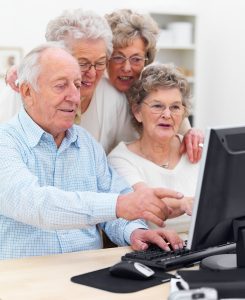Human contact is essential to our health and well-being, especially as we age. Lack of human contact has been associated with depression, loss of appetite, increased cognitive impairment, and even hypertension. Human contact is so important, in fact, that according to the National Institutes of Health, loneliness and isolation are predictors of “declining health and poor quality of life” in the elderly.
As we age, it can be hard to maintain the social contacts we need, simply because health problems and mobility issues make reaching out to the community around us increasingly difficult. This makes interactions with loved ones that much more important. They can provide that essential human contact we all need to thrive.
Unfortunately, not every family enjoys the luxury of living close enough to their aging loved ones to visit as often as they would like. Do you live too far away from your loved one to provide the face-to-face contact he or she needs to stave off the effects of loneliness and isolation? Don’t worry. Below are three easy ways you can stay in touch with your elderly loved one, even when you live far away:
- Make use of good, old-fashioned snail mail. Most of us don’t even think of sending a letter these days. After all, phone calls and text messages are right there at our fingertips and just so easy to use. However, many older people still remember when snail mail was the primary means of keeping in touch with friends and family far away, and they often love checking the mailbox every day, hoping to find a hand-written treasure. Consider sending letters and cards as a way of staying in touch with your loved one. Your messages don’t have to be long or complex. Even a quick, “Thinking of you!” can brighten your loved one’s day. Knowing that a letter might come in the mail will also give your loved one something to look forward to, and a reason to get dressed and out of the house — even if it’s just for a trip down the driveway to the mailbox.
- Pick up the phone. Phone calls are a great way to connect with older loved ones. Not only will they be pleased to hear from you, but you will be able to check on their well-being by noticing how fast they answer the phone and listening to how they sound. Don’t plan to just try to call “when you can,” either. If you’re like most people with a busy life, that extra hour of time simply won’t materialize. Instead, make a “phone date” with your loved one: A specific day and time when you will call each week. Coordinate with other family members, as well. You can each call on a different day, so your loved one will get some needed attention throughout the week.
- Don’t underestimate technology. Technology is not just for the young. According to the Pew Research Center, 56 percent of online users over age 65 have Facebook accounts, and 31 percent of all seniors use the Internet. If your loved one is comfortable with a computer, use it as a means to stay in touch. Send emails or short, cheerful text messages on a regular basis. Use Skype, as well, for a real face-to-face conversation. If your loved one has problems configuring or using computer technology, try to be sure he or she is set up with computer, camera and mic the next time you visit. You can also enlist the help of the younger generation. The grandkids could be asked to volunteer to be their grandparent’s own, private tech-support team, available over the phone to answer any computer questions or problems that arise.
Staying in touch doesn’t have to be complicated or time consuming; it just needs to be heartfelt. Taking the time to reach out to elderly loved ones is a simple gesture that will greatly improve their quality of life.
Author Bio: Michele Teter is the co-founder of Alliance Homecare, a home care provider located in the New York area. At Alliance Homecare, Teter and her team provide a range of services to match every client’s individual wants and needs.

